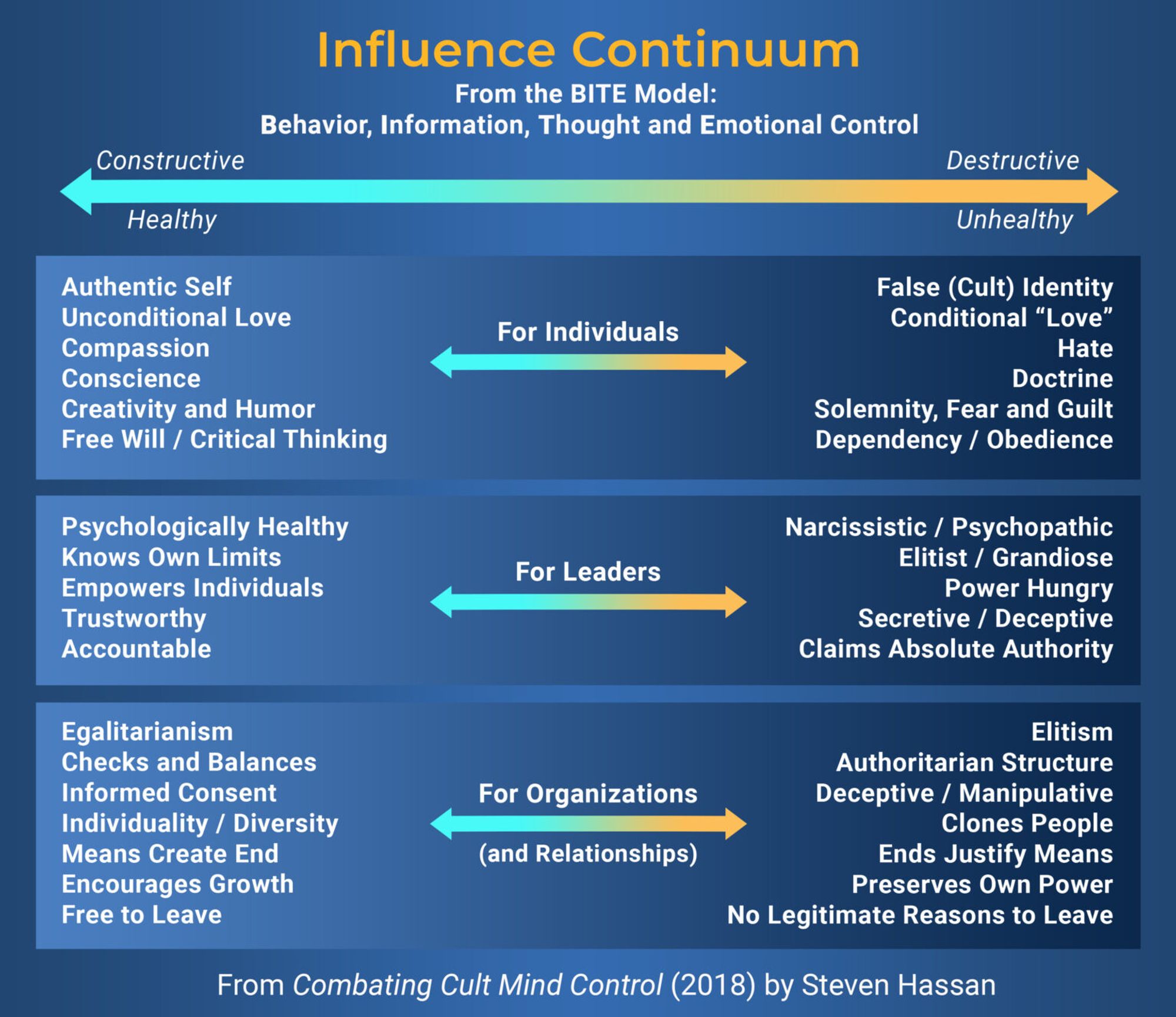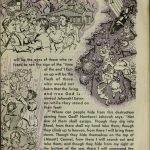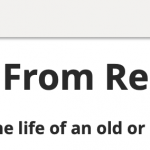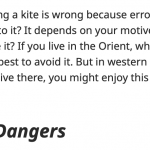There’s not a single person who wouldn’t get prickly at the suggestion that they are in a cult, if they haven’t come to that conclusion themself.
Jehovah’s Witnesses refute suggestions that they are a cult with counterarguments like: they don’t have one single charismatic leader, members live in their own homes rather than an isolated compound, there are no mass weddings, and that they strictly adhere to rules set out in the bible.
Terms like cult, mind control, and brainwashing are nebulous and if you are actually in a high-control group of some sort (it’s not only religions!), this vocabulary is sure to shut down any internal curiosity about your situation.
I’ve referenced Steven Hassan’s BITE Model of Authoritarian Control in an earlier post, but I just linked out to it without really defining or relating the model to Jehovah’s Witnesses. “BITE” stands for Behavior, Information, Thought, and Emotional control.
According to Hassan “Many people think of mind control as an ambiguous, mystical process that cannot be defined in concrete terms. In reality, mind control refers to a specific set of methods and techniques, such as hypnosis or thought-stopping, that influence how a person thinks, feels, and acts.”
In each of these pillars, an authority exerts control over individuals. People experiencing control as described in the BITE model may not realize that they have given another person or organization this kind of control over their lives.
To quote Hassan again: “Destructive mind control can be determined when the overall effect of these four components promotes dependency and obedience to some leader or cause; it is not necessary for every single item on the list to be present.”
In this post, I’m just going to share the model. In future posts, I want to take each of the four model pillars and give examples of how JW life and culture is shaped by these control methods.
Behavior Control
- Regulate individual’s physical reality
- Dictate where, how, and with whom the member lives and associates or isolates
- When, how and with whom the member has sex
- Control types of clothing and hairstyles
- Regulate diet – food and drink, hunger and/or fasting
- Manipulation and deprivation of sleep
- Financial exploitation, manipulation or dependence
- Restrict leisure, entertainment, vacation time
- Major time spent with group indoctrination and rituals and/or self indoctrination including the Internet
- Permission required for major decisions
- Rewards and punishments used to modify behaviors, both positive and negative
- Discourage individualism, encourage group-think
- Impose rigid rules and regulations
- Punish disobedience by beating, torture, burning, cutting, rape, or tattooing/branding
- Threaten harm to family and friends
- Force individual to rape or be raped
- Encourage and engage in corporal punishment
- Instill dependency and obedience
- Kidnapping
- Beating
- Torture
- Rape
- Separation of Families
- Imprisonment
- Murder
Information Control
- Deception:
a. Deliberately withhold information
b. Distort information to make it more acceptable
c. Systematically lie to the cult member - Minimize or discourage access to non-cult sources of information, including:
a. Internet, TV, radio, books, articles, newspapers, magazines, media
b. Critical information
c. Former members
d. Keep members busy so they don’t have time to think and investigate
e. Control through cell phone with texting, calls, internet tracking - Compartmentalize information into Outsider vs. Insider doctrines
a. Ensure that information is not freely accessible
b. Control information at different levels and missions within group
c. Allow only leadership to decide who needs to know what and when - Encourage spying on other members
a. Impose a buddy system to monitor and control member
b. Report deviant thoughts, feelings and actions to leadership
c. Ensure that individual behavior is monitored by group - Extensive use of cult-generated information and propaganda, including:
a. Newsletters, magazines, journals, audiotapes, videotapes, YouTube, movies and other media
b. Misquoting statements or using them out of context from non-cult sources - Unethical use of confession
a. Information about sins used to disrupt and/or dissolve identity boundaries
b. Withholding forgiveness or absolution
c. Manipulation of memory, possible false memories
Thought Control
- Require members to internalize the group’s doctrine as truth
a. Adopting the group’s ‘map of reality’ as reality
b. Instill black and white thinking
c. Decide between good vs. evil
d. Organize people into us vs. them (insiders vs. outsiders) - Change person’s name and identity
- Use of loaded language and clichés which constrict knowledge, stop critical thoughts and reduce complexities into platitudinous buzz words
- Encourage only ‘good and proper’ thoughts
- Hypnotic techniques are used to alter mental states, undermine critical thinking and even to age regress the member
- Memories are manipulated and false memories are created
- Teaching thought-stopping techniques which shut down reality testing by stopping negative thoughts and allowing only positive thoughts, including:
a. Denial, rationalization, justification, wishful thinking
b. Chanting
c. Meditating
d. Praying
e. Speaking in tongues
f. Singing or humming - Rejection of rational analysis, critical thinking, constructive criticism
- Forbid critical questions about leader, doctrine, or policy allowed
- Labeling alternative belief systems as illegitimate, evil, or not useful
- Instill new “map of reality”
Emotional Control
- Manipulate and narrow the range of feelings – some emotions and/or needs are deemed as evil, wrong or selfish
- Teach emotion-stopping techniques to block feelings of homesickness, anger, doubt
- Make the person feel that problems are always their own fault, never the leader’s or the group’s fault
- Promote feelings of guilt or unworthiness, such as:
a. Identity guilt
b. You are not living up to your potential
c. Your family is deficient
d. Your past is suspect
e. Your affiliations are unwise
f. Your thoughts, feelings, actions are irrelevant or selfish
g. Social guilt
f. Historical guilt - Instill fear, such as fear of:
a. Thinking independently
b. The outside world
c. Enemies
d. Losing one’s salvation
e. Leaving or being shunned by the group
f. Other’s disapproval - Extremes of emotional highs and lows – love bombing and praise one moment and then declaring you are a horrible sinner
- Ritualistic and sometimes public confession of sins
- Phobia indoctrination: inculcating irrational fears about leaving the group or questioning the leader’s authority
a. No happiness or fulfillment possible outside of the group
b. Terrible consequences if you leave: hell, demon possession, incurable diseases, accidents, suicide, insanity, 10,000 reincarnations, etc.
c. Shunning of those who leave; fear of being rejected by friends and family
d. Never a legitimate reason to leave; those who leave are weak, undisciplined, unspiritual, worldly, brainwashed by family or counselor, or seduced by money, sex, or rock and roll
e. Threats of harm to ex-member and family
As I noted above, Hassan writes, “Destructive mind control can be determined when the overall effect of these four components promotes dependency and obedience to some leader or cause; it is not necessary for every single item on the list to be present.”
One might say that every religion (and other social groups) exhibit some of these characteristics. Hassan clarifies that undue influence occurs on a continuum. Though a group may have certain mores that correspond to those listed in the pillars above, if it doesn’t affect someone’s authentic self, free will, or critical thinking, then it is on the healthy and constructive end of the influence continuum.

Much more on how the JW organization fits the BITE model and specific examples of the pillars in action to come.









